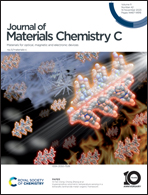2-Aryl-1,3,4-trifluoro-6,7,10,11-tetrakis(alkoxy)triphenylene: a remarkable and highly inclusive mesomorphic platform†
Abstract
Non-covalent arene–fluoroarene interactions have been increasingly exploited to create complex, soft and/or rigid supramolecular assemblies and more recently to design liquid crystals. These interactions stem from the strong electronegativity of the fluorine atoms which modifies the dipole moment of the fluorinated aromatic rings. Here, two new series of fluorine-containing triphenylene derivatives bearing 4 peripheral alkyl chains of various lengths were synthesized by nucleophilic substitution of fluoroarenes (SNFAr). A first monotonous series i.e. 2-phenyl-1,3,4-trifluorotriphenylenes (PHn, R = CnH2n+1, n = 3–12) was obtained in ca. 60–90% yields by reacting lipophilic 2,2′-dilithiobiphenyl derivatives with pentafluorobiphenyl C6F5–C6H5. Following a similar synthetic procedure, a second series of analogous compounds with larger functional aryl pending moieties, i.e. 2-aryl-1,3,4-trifluorotriphenylene derivatives, such as naphthalen-1/2-yl (NAA/NAB), benzothiophen-2-yl (BT), triphenylen-2-yl (TP), pyren-1-yl (PY) and tetraphenylethylenyl (TPE), were also prepared and obtained in moderate to high yields. Quite remarkably, induction and/or stabilization of columnar mesophases were systematically observed for all these new fluorine-containing triphenylene derivatives. PHn show a wide range of Colhex phases including room temperature phases with clearing temperatures that gradually decrease with the lengthening of alkyl chains, in contrast to the analogous non-fluorinated triphenylene derivatives deprived of liquid crystal properties. BT8, NAA8, NAB8, TP8, PY8, and TPE8 consistently display a columnar hexagonal (Colhex) mesophase while their mesophase ranges, though also broad, depend strongly on the size and bulkiness of the side aromatic residue. This study demonstrates the essential role played by aromatic fluorination and the predominance of arene–fluoroarene supramolecular interactions in the effective induction of mesophases by directing face-to-face stacking of aromatic rings of opposite nature. An X-ray single-crystal structure of PH0 indeed reveals the presence of such arene–fluoroarene interactions in the solid state and the antiparallel π–π stacking pattern. All the fluorinated molecules show blue photoluminescence in diluted solution, with the fluorescence absolute quantum yield as high as 57% for the PY-containing triphenylene. PY8 exhibits a high hole transport mobility rate on the order of 10−3 cm2 V−1 s−1, measured using the TOF technique, which is similar to those of other triphenylene-containing homologues.



 Please wait while we load your content...
Please wait while we load your content...